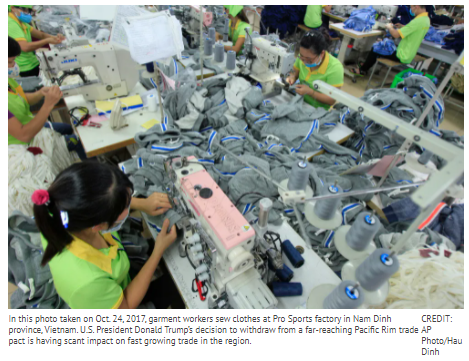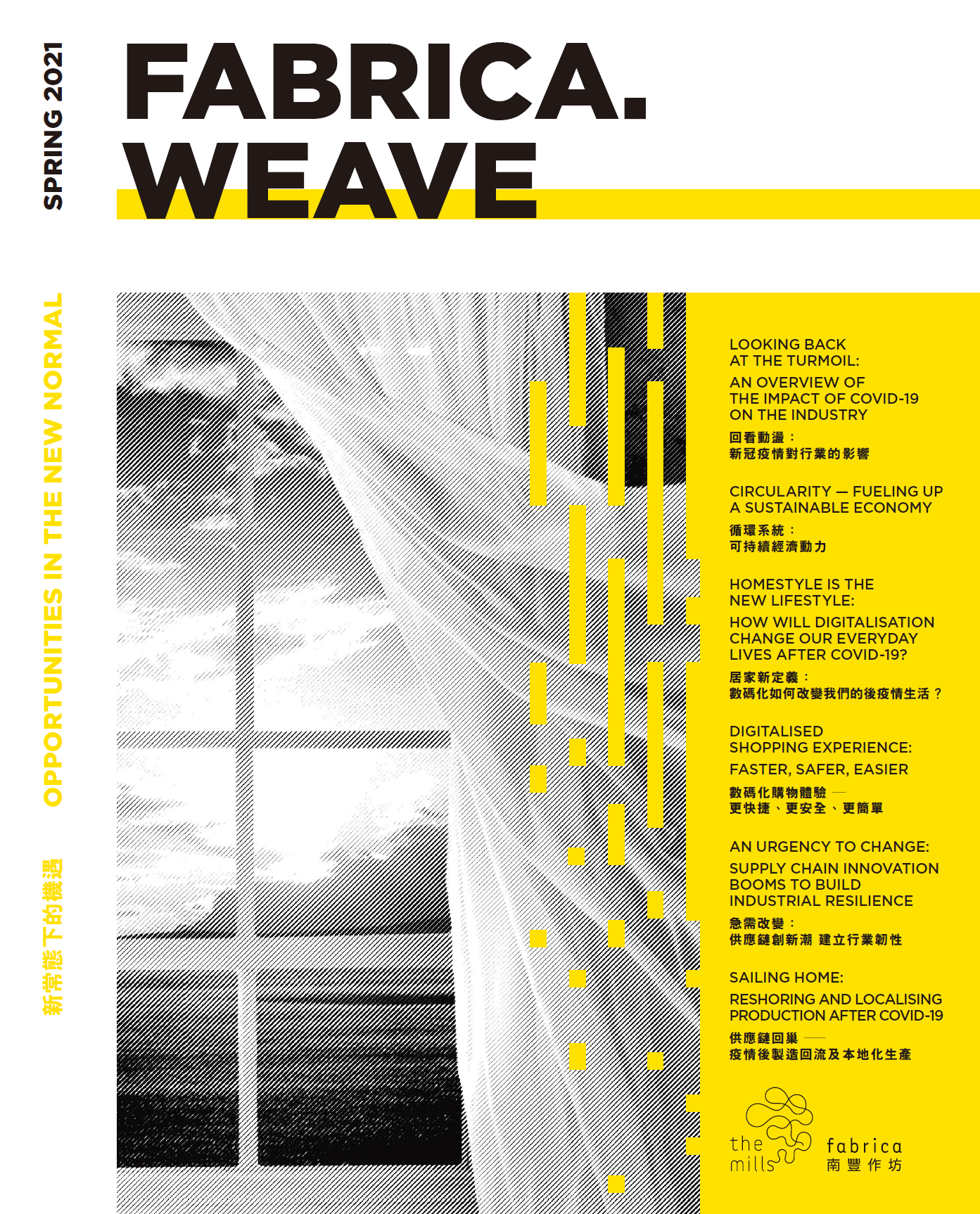2021.05.14
INDUSTRY NEWS - 2021.05.14
1、印度爆疫嚇走定單 中國紡織業受惠 內地首4月整體進出口增速 10年來最高
印度新冠疫情全面失控,內媒報道,印度是僅次於中國的紡織製造大國,受此次疫情影響,大量歐美紡織定單已轉向中國。今年1至4月,中國紡織產業出口額達439億美元,按年增18%。此外,中國的醫藥行業包括原料藥、疫苗,亦將迎來出口新局面。
中國商務部表示,今年首4月中國外貿發展延續增長勢頭,進出口增速創10年來最高水準。
首4個月內地紡織出口 年增18%
截至本港昨晚11時,印度累計逾2,289萬人確診,全國近半邦自行封城,多個行業受重創。據內媒《界面新聞》報道,印度是僅次於中國的世界第二大紡織製造國和出口國,紡織業在印度國內生產總值(GDP)中佔比2%,貢獻了7%的工業產值。疫情肆虐下,本來是中國出口的替代者和競爭者,印度無形中為中國企業提供了更多的機會。
據中國海關總署公布的全國出口重點商品量值數據,以美元計,紡織紗綫、織物及其製品今年首4個月出口額達439億美元,按年增長18%。同樣迎來高度增長的還有服裝及衣着附件商品,今年首4個月出口額達444億美元,按年增長逾5成。
原材料現棉花缺口 華出口或增
從上游原材料端來看,印度疫情帶來的全球棉花缺口,或令中國棉花出口提升。數據顯示,自2020年5月起,中國棉花產量世界佔比就已反超印度,至今維持在24%。
在製藥領域中,印度和中國也是全球數一數二的原料藥供應國,佔全球比重分別約12%和9%。目前印度的防疫舉措,或將對當地的原料藥產能構成衝擊,由此導致的產能不足,或致相關定單轉向中國。
原料藥疫苗 印度供應力勢受損
另外,作為全球最大的疫苗生產基地之一,印度參與了世界衞生組織(WHO)主導的新冠疫苗實施計劃(COVAX),隨着國內疫情惡化,印度疫苗供應能力大幅下降,中國疫苗也有望迎來出口新局面。
中國商務部外貿司表示,今年1至4月,中國外貿發展延續增長勢頭,進出口總值達11.62萬億元人民幣,按年增28.5%,規模創新高。其中,出口按年增33.8%,創2011年以來同期最高水平;與2019年同期相比,出口增長24.8%。
按美元計,中國今年1至4月,進出口總值達1.79萬億美元,按年增長38.2%。其中,出口9,737億美元,按年增長44%,比2019年同期增長30.7%。
不過,印度疫情也令中國外防輸入的難度上升,同時還帶來全球運輸、航運方面的挑戰,全球經濟復甦不免再被推遲,國際大宗商品價格上漲的問題也值得關注。海關總署上月表示,世界經濟形勢依然複雜嚴峻,中國外貿發展面臨諸多不穩定不確定因素。
資料來源:香港經濟日報 (2021年5月11日)
2、3D軟件公司 助服裝行業數碼轉型
受到疫情衝擊,無論任何行業都講求轉型,惟對比於汽車、金融等行業,服裝行業的數碼轉型步伐較為緩慢。本地有軟件初創企業,專為服裝品牌及零售商提供3D軟件技術及服務,讓品牌在設計、製造過程中,可縮短產品開發及推出市場時間,並加速數碼轉型。
LFX公司上月宣布成立「UNIFi3D」3D軟件即服務公司,其行政總裁林崇禮指出,過去3年,本在利豐內的UNIFi3D團隊,曾與全球逾100間服裝品牌及零售商合作,幫助不同品牌及零售商加速轉型。其服務總監李靄如(Idy)表示,除了服裝品牌外,也有與售賣珠寶首飾、家具產品等品牌合作,旗下客戶近9成來自海外,主要遍布於歐美地區。
製衣業為傳統行業,業內採用科技工具的步伐緩慢。早於4年前,Idy已意識到服裝行業轉型的必要性。「一般產品需要3至6個月時間作研究,其後設計師需要改動、設計不同樣品及款式供客人選擇,其運作過程需時又繁複。」她認為,服裝業不但要轉型,更要注重利用科技提升經營效率。
此外,疫情下服裝行業在經營及運作上遇到更多困難。「以前買家可直接到香港、東南亞等地,與設計師溝通,檢查成品質量。現時大部分只能透過綫上進行,生產進度也因而拖慢。」不過她也稱,疫情促使各行業數碼轉型,企業比以往更注重科技,更有不少人開始關注3D數碼技術。
減產品開發時間 提前銷售
事實上,近年服裝品牌已加大採用科技工具,不少高級時裝的生產工序已全面虛擬化,或推出數碼服裝。Idy表示,公司旗下提供的數碼產品及服務,可有助企業縮減產品開發時間及費用,甚至可在產品製造前進行銷售和行銷。
她分享,公司曾與美國某大型百貨商店合作,為他們提供3D製造及設計等技術。該公司大量減少構思、設計及與廠商溝通的時間,更可運用以往曾使用的布料及款式等,再設計出新款式,從中節省70%製作樣品的費用,並縮短一半製作時間。
不過,服裝業要由傳統過渡至數碼化,在經營模式上也必須作出轉變,並需要一段時間適應。Idy指出,傳統製衣業要透過模特兒試衫,設計師要親自挑選布料等,但採用3D數碼化工具,設計師要使用電腦運作,甚至要遙距操控原本的產品設計、製造及生產過程改變,企業各部門也需時間適應及配合。
她也指出,現時仍有不少設計師只會繪畫2D設計圖,要懂得用3D設計,首先設計師需對衣服的製造過程有所認識,並需要學習使用科技軟件。該公司旗下有7至8成員工為3D設計師,可為企業提供相關的技術知識及協助。
Idy表示,現時公司團隊約有100人,主要為3D設計師、紙樣師傅、採購員、軟件工程師及技術人員等。她稱,未來公司會繼續專注時裝設計、3D設計科技,為更多企業提供數碼產品及服務,推動業內數碼轉型。
全球趨勢 關注可持續消費
紡織服裝行業在生產過程中,需要利用大量自然資源,並會在染色、洗水等製作工序中,衍生危害生態的化學副產品,為社會及環境帶來影響。隨着全球消費者趨勢轉變,UNIFi3D服務總監李靄如(Idy)表示,現今消費者更加關注可持續消費,企業從設計到生產過程中,也應考慮環保因素。
Idy認為,現時服裝業變得更加透明化,消費者會想了解產品的生產及製作過程,並關注可持續消費議題。她指出,為滿足消費者的環保訴求,企業可利用科技減少對環境污染及製造廢物。「例如設計師可利用3D技術,預覽成品製造出來的效果,在選定不同款式、顏色的樣品後,再送到工廠製造樣品,不但節省樣品來回寄送的時間,更可減少不製造產品的樣品數量,促進可持續發展。」
疫情下零售行業出現新常態,消費者喜愛在網上購物。她指現時網店及品牌的選擇眾多,消費者也更主動尋求自己喜歡的品牌,並希望在購物上擁有更多選擇。相信實行可持續發展的企業,會更容易獲得消費者關注。
資料來源:香港經濟日報 (2021年5月11日)
3、瑞信:數字人幣難威脅美元 加快國際化進程 增強幣策傳導性
中國人民銀行對數字貨幣的研發和實踐領先全球其他央行,日前上海「五五購物節」中,不少商家都接受數字人民幣(DCEP)支付,進一步推動DCEP試點應用;除了境內應用,輿論亦探討DCEP跨境使用會否威脅美元在全球的主導地位。瑞信首席中國經濟師王一接受本報專訪時表示,DCEP對人民幣國際化沒有決定性作用,但有可能會加快這一進程。他認為,DCEP主要針對境內使用,若實現大範圍推廣,將增強人行貨幣政策的效力和傳導性能,並降低影子銀行等風險。
10年內全自由兌換機會微
王一指出,人民幣國際化是國家中長期戰略目標,惟DCEP對人民幣國際化既非充分條件,也非必要條件。人民幣國際化其中一個必備條件是資本項目的自由兌換,儘管中國一直在向前推進,預計未來5年至10年實現完全自由兌換的機會不大;但若DCEP可兌換性比傳統人民幣更強,則有可能加速人民幣國際化的節奏。
至於數字人民幣會否威脅到美元的全球地位,他不諱言,當人民幣的可兌換性大部分被滿足,DCEP境外推廣和使用,有可能規避一些對其他貨幣依賴的風險,但距離威脅美元的國際地位還很遠。在他看來,DCEP主要針對境內使用,「中國央行推出的DCEP,如果可以大面積推廣和被使用,會增強貨幣政策的有效度和傳導性能,這將成為優勢」。
近期數字人民幣加速推進,人行副行長李波日前於博鰲亞洲論壇透露,央行正在考慮擴大數字人民幣試點;而日前上海「五五購物節」中,不少商家收銀台都支援顧客選用數字人民幣付款。王一提到,根據央行公開資料,數字貨幣重點是替代流通貨幣(M0),不過,一旦獲國民廣泛接受,將自然而然滲透至(狹義貨幣)M1、M2(廣義貨幣)。從傳統貨幣政策的角度,央行直接掌握的是M0,透過傳導機制,影響到M1、M2,故DCEP的廣泛應用,勢必影響到貨幣傳導機制。
助降影子銀行風險
王一稱,過去中國的商業銀行在對非國企貸款(包括公司和個人)上,信貸配置效率不太高,某種意義上,這是導致影子銀行潛在風險的一個主要原因。若DCEP獲得大範圍推廣,流動性在經濟體中的走向就看得很清楚,從而提高信貸配置效率,達到央行一直提及的「有針對性的貨幣政策」。從另一角度,如果傳統商業銀行可以把握住數字人民幣帶來的轉變機遇,在信貸分配領域,它們至少有機會奪回自己應有的位置。
數字人民幣的廣泛應用,甚至有機會為中國降低企業增值稅鋪路。王一解釋,當政府能更好地追蹤並核實交易,增值稅的潛在稅基有望擴大,從而達到整體減稅卻不對財政收入造成負面影響的效果。他在其研究報告中引用經濟合作與發展組織(OECD)的數據指出,因管理不善、逃稅和欺詐行為,導致中國55%的潛在增值稅未能徵收。
資料來源:信報財經 (2021年5月10日)
4、京促增加重災行業支援 挺發3000億小微企業債
【明報專訊】國務院總理李克強昨日召開國務院常務會議,要求加大對受疫情影響行業的金融支持,包括對民航、文旅、線下零售、住宿、交通運輸等行業的金融服務,以及對製造業升級發展的融資支持。此外,會議要求進一步加強小微金融服務,試點建立個體工商戶信用貸款評價體系;支持發行不低於3000億元(人民幣,下同)的小微企業專項金融債,以及確保5間國有大型銀行的普惠小微貸款增長達到30%以上。會議亦提出要做好市場調節應對大宗商品價格急速上升的連帶影響。
中國4月金融數據全遜預期
人行昨公布,4月份廣義貨幣(M2)增速8.1%,較3月低1.3個百分點,差過市場預期的9.2%,是2019年7月後新低。4月新增貸款1.47萬億元,較3月份的2.73萬億元有顯著收窄,低於估計的1.6萬億元。4月社會融資規模增量為1.85萬億元,遜預期的2.29萬億元,也比3月的3.34萬億元有所收縮。
此前市場已預計,隨着信貸需求減弱及監管嚴查經營貸,4月新增信貸料大降。社融規模增量大減,亦與企業債融資低迷、政府債券尚未大規模放量有關,4月企業債券淨融資3509億元,按年少5728億元;政府債券淨融資3739億元,按年只多382億元。
人行委員:融資需求減少
人行貨幣政策委員會委員王一鳴卻認為,4月數據反映金融體系對實體經濟仍保持較強支持力度。一方面新增貸款對比2019年增加4525億元,表明企業融資需求仍然旺盛;另一方面,去年同期企業受疫情衝擊,自有資金嚴重不足,需要額外融資支持。而今年以來經營明顯好轉,流動資金相對充裕,融資需求相應有所減少。
資料來源:明報 (2021年5月13日)
5、Vietnam Won the US-China Tariff War
Monthly imports from Vietnam have been rising steadily on a year-over-year basis since June 2020, and the year-to-date figures show they doesn’t appear to be leveling off anytime soon.
Data from the U.S. Census Bureau shows that for March, the most recent monthly tally available, U.S. imports from Vietnam were $8.80 billion, up sequentially from $6.76 billion in February and reflecting a 70 percent spike from $5.18 billion in March 2020. The February total saw $6.76 billion in imports, a sequential dip from $7.66 billion in January, but a 12 percent increase from $6.03 billion in February 2020. And January’s $7.66 billon in imports was a sequential increase from $6.92 billion in December 2020, which also represented a 20 percent jump from December 2019. As for 2020 monthly compares from the same year-ago tallies in 2019, most months saw increases except for March and May 2020, when imports from Vietnam were down from 2019 figures.
A look at the available data from the Census Bureau showed that imports from Vietnam have shown steady year-over-year growth since 1994 when imports reached $50.5 million from zero the year prior, the numbers indicate. However, it wasn’t until 2019 when total imports spiked 36 percent to $66.63 billion from 2018’s $49.16 billion that the monthly import figures began an upward trajectory that has yet to slow down.
In 2018, many apparel companies were already in a multi-year process of moving production away from China amid rising labor costs. Some looked to India, while others eyed Vietnam.
The start of the U.S.-China trade war on July 6, 2018, when the U.S. under the Trump administration imposed a 25 percent tariff on $34 billion of Chinese imports, further accelerated anywhere-but-China sourcing. That was the first in a series of tariffs that has only escalated via multiple tranches in the months that followed. Former President Trump tabled a 25 percent tariff on $300 billion of Chinese imports in June 2019. That didn’t last long as the U.S. slapped an additional 10 percent tariff on $300 billion worth of Chinese imports two months later starting Sept. 1, 2019.
For apparel production, Asian countries that saw gains included Vietnam, India, Bangladesh, Myanmar and Cambodia. Companies also looked elsewhere for production, such as Turkey.
One question looming on the horizon is whether the U.S. Trade Representative will at some point impose new tariffs on goods from Vietnam. The USTR has determined that Vietnam’s practices related to currency valuation had harmed U.S. commerce. The USTR in January decided to hold off on new tariffs for now, just before the Biden administration took over, but that could change at any moment.
For now, the main loser seems to be China. According to the U.S. Census Bureau, imports from China in 2018 totaled $539.24 billion, a 7 percent increase from $505.17 billion in 2017. Following the imposition of tariffs, 2019 imports from China fell 16 percent to $451.65 billion from 2018’s tally. And in 2020, imports fell again by 4 percent to $435.44 billion.
Because of the impact from the coronavirus pandemic in 2020, data from 2021 as the year progresses will help determine what will be the trend for imports from China in the months ahead. For the three-month tally from January to March 2021, imports totaled $113.37 billion, representing a 49 percent gain from the comparable 2020 period of $75.90 billion when China was hard hit by the pandemic, but just a 7 percent increase from $105.84 billion in the same 2019 period.
So far, the Biden administration is keeping Trump’s tariffs in place. The USTR delivered Biden’s 2021 Trade Agenda to Congress in March, recognizing China’s trade policies as harming U.S. workers, threatening America’s technological edge and weakening its supply-chain resiliency, not to mention undermining national interests. For now, the key priority for Biden appears to be focusing on rebuilding the U.S. economy and fighting the coronavirus pandemic. On March 12, he signed a $1.9 trillion Covid relief bill into law, which was welcomed by retail trade groups the National Retail Federation and the American Apparel & Footwear Association.
Source: www.sourcingjournal.com (12 May 2021)
6、New Bangladesh textile hub to boost exports
The Bangladesh clothing industry is looking forward to the completion of five state-of-the-art textile factories at the Korean Export Zone (KEPZ) as an important expansion of local backward linkages.
Source: www.just-style.com (13 May 2021)
7、Gap Inc. CEO Outlines Path to Becoming ‘Most Inclusive Company in the World’
Hoping that its Power Plan 2023 strategy steers it back in the right direction, Gap Inc. CEO Sonia Syngal believes that the future hinges on the fact that the business “can and should be a force for good.”
At the clothing company’s annual shareholders meeting, Syngal reiterated the company’s commitment to environmental social and governance (ESG) provenance while highlighting its sustainability efforts.
On the path to becoming what Syngal calls “the most inclusive company in the world,” Gap Inc. created an action plan in 2020 focused on three areas: employee belonging, customer belonging and community belonging, with commitments in each area set for 2025.
“We’re working harder than ever to make our business more sustainable, by setting bold goals, designing new programs and partnering with others to change our industries for the better,” Syngal said. “Along with our employees, we are committed to fostering a culture of belonging, besides Gap Inc. and beyond our walls, because our journey towards full equality and inclusivity is never quite complete.”
In June, the retailer will release its first annual progress report on this work.
Earlier this month, Gap unveiled that it was a founding member of the Second Chance Business Coalition (SCBC) through its partnership with the Business Roundtable. Alongside Walmart, The Home Depot, Verizon and PepsiCo, among others, the San Francisco will help lower barriers to employment for people with a criminal record and support its inclusive workforce strategy.
The retailer also has partnered with Harlem’s Fashion Row with its “Closing the Gap” initiative, offering financial awards to fashion departments at Historically Black Colleges and Universities (HBCUs). Gap, Inc. is contributing $510,000 to the initiative, which will be distributed across 21 awards ranging from $10,000 to $100,000, providing a platform designed to empower Black students to propel their studies and drive innovation within the fashion industry.
In the presentation, Syngal also highlighted that 800,000 women and girls have completed its Personal Advancement and Career Enhancement (P.A.C.E.) program since it was founded in 2007. P.A.C.E. was developed to give women the foundational life skills, technical training and support that will help them advance in the workplace and in their personal lives.
“Through our business practices and the influence of our brand, we are unleashing the power of inclusion to change lives in the world for the better today and for future generations,” Syngal said. “Building on our legacy of empowerment programs for women and young people entering the job force and elevating those who make our business possible, we are focused on enabling equality and access to opportunity.”
Environmentally, Gap has saved 11.2 billion liters of water in the manufacturing process since 207, and has a 65 percent diversion rate of plastic waste across its stores and distribution centers.
The retailer purchases 99 megawatts of power annually from the 299-megawatt Aurora wind farm in North Dakota developed by Enel Green Power. The wind energy supplied to Gap Inc. under the agreement is enough to power over 1,500 Gap Inc. retail stores.
Beyond Gap Inc.’s ESG and sustainability milestones, the company also voted on five proposals.
Via shareholder votes, Gap confirmed the election of its 13-member board of directors, and ratified the selection of Deloitte & Touche LLP as its independent registered public accounting firm for the fiscal year ending Jan. 29, 2022.
Of the board, which includes Syngal, six of the 13 directors are women. The directors will serve until the next annual meeting. Deloitte & Touche (or its predecessor firm) has been retained as Gap, Inc.’s independent accounting firm since 1976.
Additionally, the shareholders approved the overall compensation of Gap Inc.’s executive officers, and approved the amendment and restatement of both the company’s employee stock purchase plan and its 2016 long-term incentive plan.
Source: www.sourcingjournal.com (11 May 2021)
8、Wrap launches sustainability initiative 'Textiles 2030', major retailers sign up
UK non-profit Wrap has launched Textiles 2030, a new initiative aiming to transform the fashion and textiles sector into “a climate-neutral and profitable industry that is fit for the future”.
Thirty-five organisations have so far signed up to the initiative, including Ted Baker, Next, Marks & Spencer, John Lewis & Partners, Oxfam, Primark, Gymshark, Asos, Boohoo, Re-Fashion, The British Fashion Council and The British Retail Consortium.
The voluntary agreement, funded by its signatories and the government, sets out a number of carbon, water and circular textiles targets to be met by 2030. Signatories will also contribute to national policy discussions with UK governments to shape Extended Producer Responsibility and other critical regulatory developments.
Shared targets include reducing the aggregate greenhouse gas footprint of new products by 50 percent, and cutting down the aggregate water footprint of new products sold by 30 percent. Signatories will also set out individual targets and report back to Wrap on their progress.
Retailers join up for 10-year sustainability targets
“It is clear the sector needs to break the pattern of take, make, and dispose and move towards a circular system where products are re-used and recycled more easily,” Wrap said on its website.
Textiles 2030 follows Wrap’s Sustainable Clothing Action Plan 2020 (SCAP), an earlier initiative that saw businesses achieve significant reductions in their carbon and water footprints during the eight year programme.
A virtual event is taking place on April 26 to mark the launch of Textiles 2030 led by an expert panel including Wrap CEO Marcus Gover, baroness Lola Young, environment minister Rebecca Pow, and head of Wrap Global Richard Swannell.
Guest speakers also include Marks & Spencer, Thrift+, Ganni and Fashion Revolution.
“As one of the founding signatories of Textiles 2030, Frasers Group is proud and excited to be collaborating with fellow leading retailers and others to reduce the impact of the textiles industry on the environment and climate change,” said Dayna Wragg, sustainability lead at Frasers Group.
Gymshark chief product officer Ben Francis said: “As a young company, we’re at the beginning of our sustainability journey. This programme fits in perfectly with our sustainability strategy and will give us the opportunity to develop meaningful collaborations and projects that will be key to achieve our targets.
“We’re fully committed to putting sustainability at the heart of everything we do, so we’ll play our part in reducing emissions, virgin resources, and developing products that follow circularity principles.”
Source: fashionunited.uk (26 Apr 2021)
9、Fung Business Intelligence: China Trade Quarterly - Issue 62
China Trade Quarterly Issue 62 (May 2021)
https://www.fbicgroup.com/sites/default/files/China%20Trade%20Quarterly%20Issue%2062%20May%2021.pdf
For more Fung Business Intelligence publications, please visit: https://www.fbicgroup.com/?q=reports
Source: Fung Business Intelligence (7 May 2021)
10、The Mills Fabrica Publication: Fabrica.Wave
Opportunities In The New Normal Issue (Spring)
https://www.themillsfabrica.com/wp-content/uploads/2021/04/210503_fabrica_weave_vol15_digital.pdf
For more The Mills Fabrica publications, please visit: http://www.themillsfabrica.com/platform/publications/
Source: www.themillsfabrica.com (10 May 2021)








